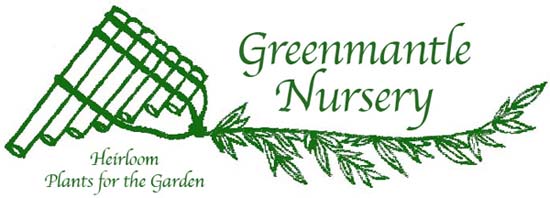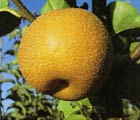
| Our Fruit Collection | ||
| Our Rose Collection | ||
Greenmantle Nursery
3010 Ettersburg Road
Garberville CA 95542
(707) 986-7504
 |
Greenmantle Nursery |
|||||||||
Asian Pears (Nashi) Our apologies: We no longer propagate / offer Asian Pear grafts or trees. We have left this page for reference only... |
|||
|
When we first started growing Asian pears, they were an exotic and hard-to-find class of fruit. We were able to get started with the help of Knox Namura of Washington State. Then came the great Asian Pear boom, with thousands of acres planted to this "new" fruit. By now, the market has leveled off due to the predictable glut of over-production. Unlike their Euro-American cousins, Asian pears need to be picked at the peak of ripeness; they do not sweeten up in storage. For this reason, many consumers have been sadly disappointed by supermarket produce specimens. Nashi are still an excellent choice for the home orchardist, ripening typically in September before the height of apple season. They grow well in most places suitable for apples and "domestic" pears. Asian pears will be an attractive feature in the garden landscape: Beautiful in bloom and in fruit, their vivid Autumn foliage colors can be particularly striking. Bartlett can be used as a pollinizer, but the Asian pears begin to flower a week or two earlier: hence, reliable pollination requires two Asian varieties. This also means that the crop is at risk in places subject to heavy late frost. RootstocksWe graft our Asian pear varieties on Pyrus betulaefolia seedling rootstock. This makes for vigorous standard trees requiring 20 foot centers. Semi-dwarf Asian pear trees on Euro-American (Pyrus communis) understock like the Old Home x Farmingdale (OHxF) series may tend to go into early decline - and cannot be recommended. ASIAN PEAR VARIETIES
|
|||
 Hosui |
The first three are russeted fruit with pronounced aromatics suggesting butterscotch or brandy. The latter two are yellow pears, very sweet and juicy - but less aromatic.
Roses: Master List
Albas
Bedding Roses
Bourbons
Centifolias
Chinas
Climbers
Damasks/Portlands
Gallicas
Hybrid Musks
Hybrid Perpetuals
Mosses
Noisettes/Cl. Teas
Ramblers
Rugosas
Special Shrubs
Species
Sweet Briers
Sweethearts
Tea Roses
* * * * * * * * * * * * *
Fruit
Collection - Rose Collection
All original text and images © Greenmantle Nursery 2005 -2020